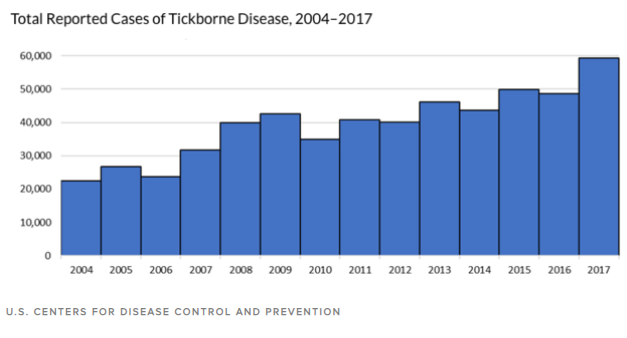Did you know that the number of U.S. counties now considered to be of high incidence for Lyme disease has increased by more than 300% in the Northeastern states and about 250% in the North-Central states? Yikes!
Recently, the record number of infections carried by ticks has hit an all-time high in the U.S. Dr. John Aucott, director of the Johns Hopkins Lyme Disease Research Center, even says that “the true number is probably 10 times that.” In fact, he says that every year the geographic distribution increases in the U.S. In November 2018, the federal Tick-Borne Disease Working Group issued a report to Congress addressing the growing threat to public health in the U.S.
Lyme disease is transmitted by a bite from a tick infected with Borrella burgdorferi bacteria (Adrion et. al 2015). According to the report to Congress, available diagnostic tests can be inaccurate and hard to interpret during the early stages of infection. This can be hard for physicians to give an early treatment to you. The best step is prevention! The report to Congress includes several things you could to prevent tick-borne illness transmissions. Check it out!

(“Tickborne Disease Surveillance,” 2019)
Tick-borne illnesses can significantly impact people. According to the Cary Institute, climate change and forest fragmentation contribute to the continual expansion of Lyme disease (“Lyme Disease Prevention,” 2017). Get this, a Johns Hopkins study approximated that tick-borne illnesses bring up a $1.3 billion cost to the U.S. healthcare system annually (Adrion et. al 2015).
With a number like that you’d wish there was more action towards prevention right? Dr. Richard Ostfeld from the Cary Institute agrees and says that maybe people will care about the loss of biodiversity if it makes them more likely to get sick.
Biodiversity has given us many environmental services for free such as filtering water or cleaning the air. The more diverse an ecosystem, the better it is provide able to given out free services. But did you know the biodiversity can also protects us against exposure to Lyme disease?
According to Dr. Ostfeld, larval blacklegged ticks will feed on just much anything with fur or feathers. However, tick larvae feeding on white-footed mice, he says, are at least twice as likely to survive and become infected than any other cute furry animals out in the woods. There furry mice love to live in disturbed, degraded, fragmented forests where their predators aren’t present looking for them. Because of forest fragmentation, animals like squirrels and opossums that kill ticks are gone. As a result, we get an environment full of ticks. Yikes! Nope, no thank you.
The Cary Institute emphasizes the need for reducing encounters with infected ticks by gaining a better understanding the environment of Lyme disease. Especially in regions beyond the Northeast and Upper Midwest, the surveillance efforts are lacking and need to get stronger. I’ve attached an informative video of Tick-borne disease ecology. It is produced by Harvard University’s Center for the Environment and Dr. Richard Ostfeld explains the ecology of Lyme disease. Here, he explains how acorns and white-footed mice increase pathogen transmission and explains the influence of predators in suppressing tick infection prevalence. It’s cute, check it out! He also addresses the impact anthropogenic changes to the environment such as climate change and forest fragmentation and its impact on rising tick infections.
Video: https://www.caryinstitute.org/discover-ecology/videos-audios/tick-borne-disease-ecology
Works Cited
Adrion, Emily R., et al. “Health Care Costs, Utilization and Patterns of Care Following Lyme Disease.” Plos One, vol. 10, no. 2, 2015, doi:10.1371/journal.pone.0116767.
“Biodiversity and Human Health: Why More Species Mean Fewer Cases of Lyme Disease.” Cary Institute of Ecosystem Studies, 28 Feb. 2010, http://www.caryinstitute.org/newsroom/biodiversity-and-human-health-why-more-species-mean-fewer-cases-lyme-disease.
“Lyme Disease Prevention: The Tick Project.” Cary Institute of Ecosystem Studies, 11 Mar. 2017, http://www.caryinstitute.org/lyme-disease-prevention-tick-project.
“Tickborne Disease Surveillance Data Summary | Ticks | CDC.” Centers for Disease Control and Prevention, Centers for Disease Control and Prevention, www.cdc.gov/ticks/data- summary/index.html.
“Tick-Borne Disease Working Group .” Tick-Borne Disease Working Group , Nov. 2018, http://www.hhs.gov/sites/default/files/tbdwg-report-to-congress-2018.pdf.

Leave a comment